Face to face with the past - the redisplay of a Roman coffin
, 28 September 2010
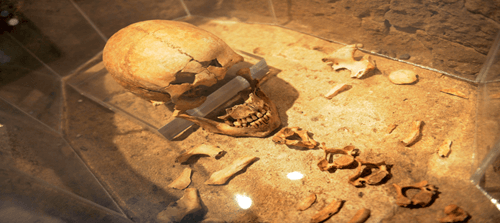
One of the most popular displays at the National Roman Legion Museum is a stone coffin that contains the skeleton of a Roman man. The coffin also contains the remains of grave goods that he would need for their next life, including the base of a shale bowl and fragments of a glass perfume or ointment bottle.
The coffin was found in 1995 on the site of a Roman cemetery just outside Caerleon. The cemetery is now part of the Caerleon Campus in the University of Wales, Newport. It has been on display in the National Roman Legion Museum from 2002, however in Summer 2010 we started working to redisplay the coffin in a fashion that is closer to its original form thanks to funding from the Friends of Amgueddfa Cymru – National Museum Wales.
Made from a solid block of Bath stone, the coffin dates to about 200AD. Since it is around 1800 years old the coffin wouldn’t be able to support the weight of its original lid which is in 2 large pieces. The sides and base of the coffin are being reinforced and the lid will sit on top of a Perspex cover with enough of a gap so that you can see the skeleton inside.
Further work will be done to find out more about our Roman man, who was about 40 when he died. Thanks to funding from the Roman Research Trust, Isotope analysis will be carried out on his teeth which should tell us where grew up and what sort of food he ate. We will also be trying to reconstruct his face so that we can produce a painted portrait of him using the same materials and techniques used by the Romans.
Follow our progress as work proceeds over the next year.
We aim to complete the redisplay by the end of 2011 when you will be able to come face to face with the past!
Step 1
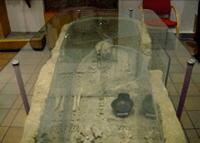
The coffin, skeleton and grave goods have been on display since 2002.
In that time it has become one of the most popular exhibits in the gallery.
Step 2
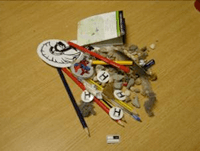
Gaps in the coffin allowed visitors to push things into the display.
These are some of the things we found, not exactly the sort of thing our Roman would like to take to the next life.
Step 3
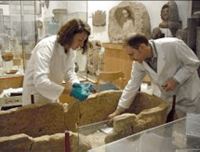
Work begins. First the skeleton and grave goods have to be removed and stored safely.
While off display the skeleton will undergo further investigation in an attempt to find more about the man buried in the coffin.
Step 4
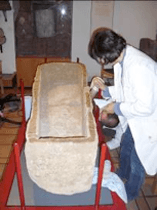
All modern materials added to an object must be reversible. This makes it easier to remove restoration without causing damage to the original artefact.
Here a reversible barrier is being painted onto the coffin. This will separate the original stonework from the material used to fill gaps and level the rim.
Step 5
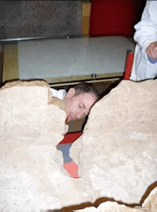
Even the most awkward places have to be reached!
Step 6
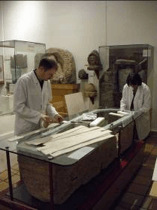
The lid of the coffin must have a level surface to sit on!
Unfortunately much of the original rim of the base has eroded so with the aid of foam, double-sided tape and the glass top of the original display as a guide, we hope to establish a new level for the coffin rim.
Step 7
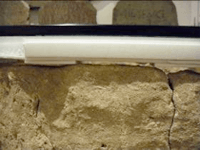
Layers of foam were stuck to the flat glass top. When the highest part of the coffin was reached this line was used as the level for the new rim.
Step 8
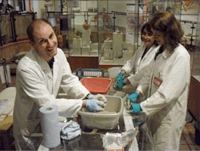
Now for the fun bit� mixing up the fill material.
This material must work like a putty and set hard when dry. Also be safe to use in the open gallery and similar in colour and texture to the original Bath stone.
We went for a mixture of air-drying clay, sand to reduce shrinkage and give texture. Acrylic paint for colour and extra bonding. This was a bit of a messy job and it took a while to get the mix right!
Step 9
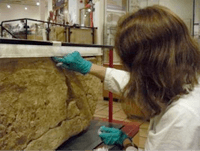
Once the mix was ready the gap between the foam and the edge of the coffin was filled.
Step 10
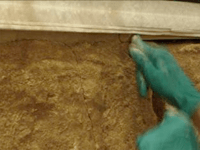
Being careful not to get excess fill material all over the stone.
Step 11
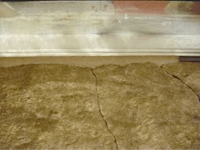
Looks good, let�s hope the fill dries without to much shrinkage.
The colour of the fill is a bit light, not as golden as the original Bath stone. The Roman quarry for the stone is believed to be south of the ancient City of Bath. The stone is soft and easily carved when wet, but becomes hard on drying.
Step 12
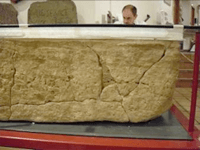
Inspecting the days work! Hopefully when the glass and foam is removed the fill will be nice and level.
Step 13
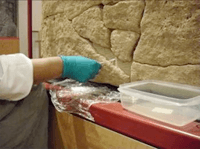
The gaps in the side of the coffin have to be filled to prevent access to the skeleton once it is put back on display.
Step 14
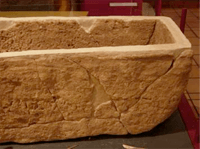
The glass top and foam are removed and the new rim revealed. The fill has dried much lighter than expected so will have to be painted to make it less obvious.
Most of the fill will be hidden by the lid which extends over the edge and down the side. This overlapping edge use to rest on a ridge that ran round the top of the coffin base.
Remains of this ridge can still be seen on the right hand-side of the image just below the fill.
Step 15
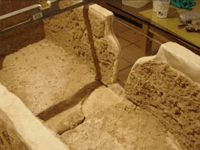
The coffin was unearthed by a mechanical digger, which broke it into several sections. Most of the pieces were retrieved, but one area was so badly damaged no pieces survived.
Instead of filling the gap to complete the side, we decided to install a viewing window so small visitors to the museum can still get a good view of the skeleton inside.
Step 16
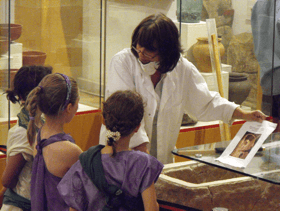
The coffin is extremely heavy and could not be moved out of the gallery safely. Therefore, all conservation work has to take place in the gallery, which has been quite challenging at times.
If you are visiting and see us there, come over and say hello, we are happy to answer any questions about the project.
